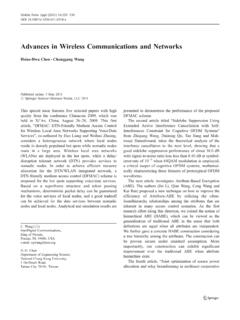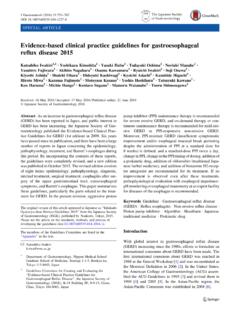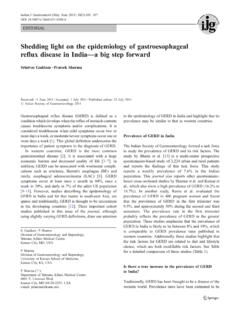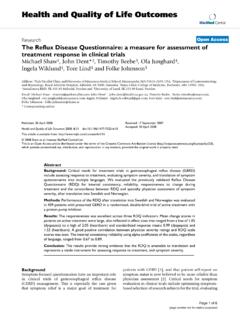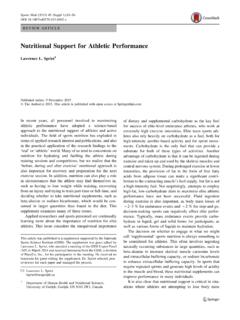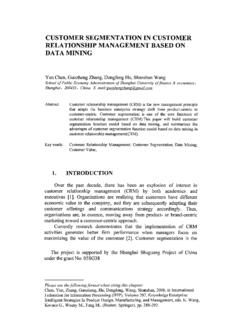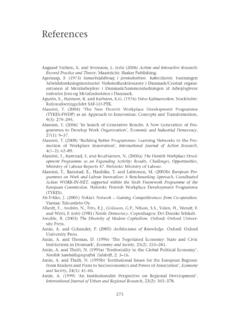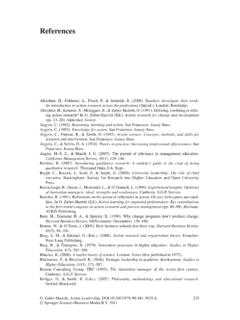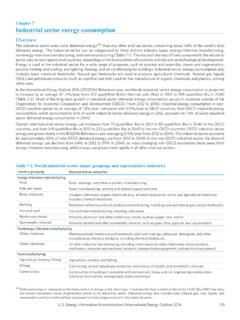Transcription of Influence of tribology on global energy consumption, costs ...
1 Friction 5(3): 263 284 (2017) ISSN 2223-7690 CN 10-1237/ TH REVIEW ARTICLE Influence of tribology on global energy consumption , costs and emissions Kenneth HOLMBERG1,*, Ali ERDEMIR2 1 VTT Technical Research Centre of Finland, VTT FI-02044, Finland 2 Argonne National Laboratory, Argonne, IL 60439, USA Received: 17 May 2017 / Accepted: 06 July 2017 The author(s) 2017. This article is published with open access at Abstract: Calculations of the impact of friction and wear on energy consumption , economic expenditure, and CO2 emissions are presented on a global scale.
2 This impact study covers the four main energy consuming sectors: transportation, manufacturing, power generation, and residential. Previously published four case studies on passenger cars, trucks and buses, paper machines and the mining industry were included in our detailed calculations as reference data in our current analyses. The following can be concluded: In total , ~23% (119 EJ) of the world s total energy consumption originates from tribological contacts. Of that 20% (103 EJ) is used to overcome friction and 3% (16 EJ) is used to remanufacture worn parts and spare equipment due to wear and wear-related failures. By taking advantage of the new surface, materials, and lubrication technologies for friction reduction and wear protection in vehicles, machinery and other equipment worldwide, energy losses due to friction and wear could potentially be reduced by 40% in the long term (15 years)and by 18% in the short term (8 years).
3 On global scale, these savings would amount to of the GDP annually and of the total energy consumption in the long term. The largest short term energy savings are envisioned in transportation (25%) and in the power generation (20%) while the potential savings in the manufacturing and residential sectors are estimated to be ~10%. In the longer terms, the savings would be 55%, 40%, 25%, and 20%, respectively. Implementing advanced tribological technologies can also reduce the CO2 emissions globally by as much as 1,460 MtCO2 and result in 450,000 million Euros cost savings in the short term. In the longer term, the reduction can be 3,140 MtCO2 and the cost savings 970,000 million Euros.
4 Fifty years ago, wear and wear-related failures were a major concern for UK industry and their mitigation was considered to be the major contributor to potential economic savings by as much as 95% in ten years by the development and deployment of new tribological solutions. The corresponding estimated savings are today still of the same orders but the calculated contribution to cost reduction is about 74% by friction reduction and to 26% from better wear protection. Overall, wear appears to be more critical than friction as it may result in catastrophic failures and operational breakdowns that can adversely impact productivity and hence cost .
5 Keywords: friction; wear; energy saving; emission reduction 1 Introduction Transportation, power generation, and manufacturing are vital industrial activities in a highly developed modern society. They involve moving both people and all kinds of materials in many different forms by all types of machines and mechanical systems that have numerous moving parts and hence interacting surfaces. * Corresponding author: Kenneth HOLMBERG, E-mail: 264 Friction 5(3): 263 284 (2017) | Smooth, reliable, and long-lasting operations of such machines are closely dependent on how well the friction and wear are controlled on their numerous interacting surfaces.
6 The science and technology for understanding and controlling friction, wear, and lubrication of such interacting surfaces in relative motion have been named as tribology since 1966 [1]. The key motivation for establishing the new discipline of tribology was the great economic impact that wear failures had in the British industry and on the British economy in the middle of last century. At the same time, a great number of new technological solutions had been developed that could be used to reduce friction and wear but they had not yet been implemented largely. The Jost report summarised that by large scale implementation of newer and more advanced tribological technologies, 515 million UK pound could be saved annually and this would correspond to of GNP at that time.
7 Most importantly, this report stipulated that such savings could be achieved in a period of ten years. The British government invested million UK pound for further development and implementation of tribology in education, research and industry, and ten years later, the savings were estimated to be 200 million UK pound annually [1 4]. The Jost report was followed by other similar studies that reported potential savings of the similar orders of magnitude in Japan ( of the GNP in 1970), in Germany ( , 1976), in the USA ( , 1977, 1981) and in China (2% 7%, 1986). The estimated savings show large differences probably due to differ-ences in the level of industrialization and industrial infrastructure of each country, the year when the calculations were carried out and the method of calculations used [4 9].
8 There has been tremendous progress in understan-ding of the fundamental mechanisms of tribological phenomena and developing a myriad of new materials, surface technologies, lubricants and other types of technical solutions, such as improved design, for markedly reducing friction and improving wear pro-tection since the time of the Jost report. Furthermore, the greater knowledge gained from worldwide tribological studies mentioned above have been imple-mented in higher education and industry. However, today we face new challenges in the society due to increased world population, growing demands for energy , and limitation of fossil fuel use due to environmental concerns.
9 In fact, at these days, it has become a great importance for the sustainability of global society to curb the use of fossil fuels and hence reduce the greenhouse gas emissions [10 12]. Figure 1 shows the International energy Agency (IEA) estimation of key technologies for reduction of CO2 emissions in order to limit the global warming to 2 C above pre-industrial levels by 2050 [13]. The largest impact (38%) is expected to come from end-use energy efficiency and in this area, tribology could contribute considerably with new technical solutions such as new materials and coatings, surface engineering (including surface treatments, modifications, and texturing), new lubricants and additives (including nanomaterials and solid lubricants); new component design with microsensors; new methodologies like biomimetics, nanotechnology and integrated com-putational material design [12, 14, 15].
10 These are all related to the concept of green tribology which has recently been introduced and defined as the tribological aspects of ecological balance and of environmental and biological impacts [16]. Both the world and the levels of technological achievements have changed much from the years of those earlier tribology impact reports. Still more recent studies on this topic are quite few, so there is a need for an update. Very recently Lee and Carpick [12] prepared a comprehensive report for the Department of energy in the USA on tribological opportunities for Fig. 1 Key technologies for reduction of CO2 emissions in order to limit global warming to 2 C [13].
